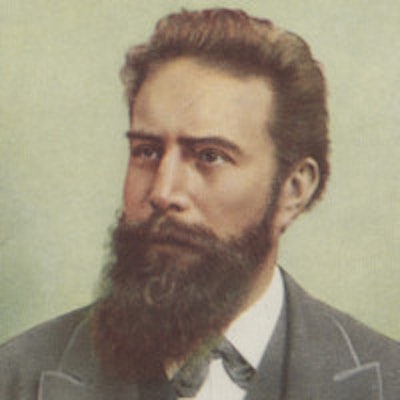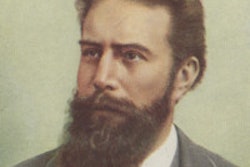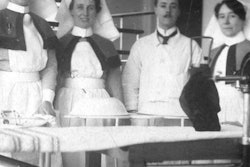
Prof. Robert Dondelinger has written an interesting account of the reception of Röntgen's discovery by the press in Vienna.1 It is worth reflecting on this historic finding and recounting the tale. There are important lessons for today.
Zacharias Lecher (1829-1905) was a reporter at the Viennese daily newspaper Die Presse. In the Sunday edition of January 5, 1896, an unsigned article was published on the front page, titled "A sensational discovery." The last paragraph starts as follows (in English translation):
And if one lets phantasy run free, one can envision that it will become possible to improve the method of photographic process using the rays emitted by a Crookes' tube in such a way, that only a part of the soft tissues of the human body remains transparent, but a deeper layer can be fixed on the plate and thus an inestimable aid would be gained for the diagnosis of numerous other groups of diseases than those of the bones. Such an achievement, such a progress on the opened track would not be out of reach of the possible, provided the preceding premise will prove correct. We admit that all this is over-audacious phantasy of the future ...
Dondelinger is from the department of medical imaging, University Hospital Sart Tilman, Liège, Belgium. As he explains, this article is the first landmark publication in the history of x-rays and was subsequently abundantly quoted in the literature, but the prophecy of tomography that was printed in the last paragraph on the second page of the newspaper was simply never spotted, in spite of being in clear view. Certainly I had not seen this, in spite of being very familiar with the article.
 Prof. Robert Dondelinger. Photo courtesy of the ESR and originally appeared in ECR Today.
Prof. Robert Dondelinger. Photo courtesy of the ESR and originally appeared in ECR Today.That a pioneer realizes the exact significance of a development is not uncommon. As another example, we have William Morton, who was an important early figure in radiology in the United States. Morton had the title of 'professor of diseases of the mind and nervous system and electro therapeutics' at the New York Post Graduate Medical School and Hospital. His book The X-Ray or Photography of the Invisible (Morton, 1896) is undated; however, the preface is dated September 11, 1896.2 Morton's co-author was Edwin Hammer, who was an electrical engineer. This book is important because it is the first book on radiology written by a physician, and Morton covers all areas of radiology known at the time with speculations about potential future uses for the new rays. Morton makes the following, very pertinent observation:
In teaching the anatomy of the blood vessels the x‑ray opens out a new and feasible method. The arteries and veins of dead bodies may be injected with a substance opaque to the X-Ray, and thus their distributions may be more accurately followed than by any possible dissection. The feasibility of this method applies equally well to the study of other structures and organs of the dead body. To a certain extent, therefore, x-ray photography may replace both dissection and vivisection. And in the living body the location and size of a hollow organ, as for instance the stomach, may be ascertained by causing the subject to drink a harmless fluid, more or less opaque to the x-ray, or an effervescent mixture which will cause distension, and then taking the picture.
Morton's words are incredibly perceptive. In this very early book, published less than a year following the discovery, Morton is not only predicting later contrast gastrointestinal studies but also the use of radiology in the equivalent of modern virtopsy (virtual autopsy).
This seems to confirm that historic figures such as Morton and Lecher are often aware of the importance of their observations, and those who come after them build on this solid foundation. Lecher predicted that subsequent developments would enable the differentiation of soft tissue structures. Morton had immediately seen that the radiological examination of the body, either living or dead, could produce more information than could be found in either the operating theatre or the pathology department. Surely we do after all stand on the shoulders of giants.
References:
1. Dondelinger, R.F. The idea of tomography was published together with the news of the discovery of Röntgen rays—a historical note. European Radiology, 26 February 2020. https://doi.org/10.1007/s00330-020-06710-2
2. Morton, W.J. The X Ray or Photography of the Invisible and its Value in Surgery. London: Simpkin, Marshall, Hamilton, Kent & Co. Ltd. (undated, preface dated 1896.)
Dr. Adrian Thomas is chairman of the International Society for the History of Radiology and honorary librarian at the British Institute of Radiology.
The comments and observations expressed herein do not necessarily reflect the opinions of AuntMinnieEurope.com, nor should they be construed as an endorsement or admonishment of any particular vendor, analyst, industry consultant, or consulting group.



















